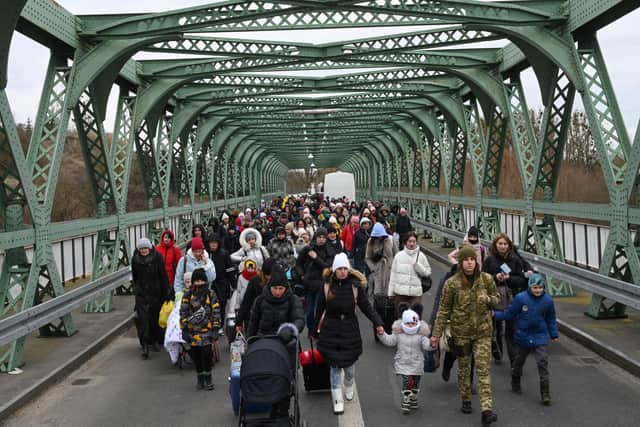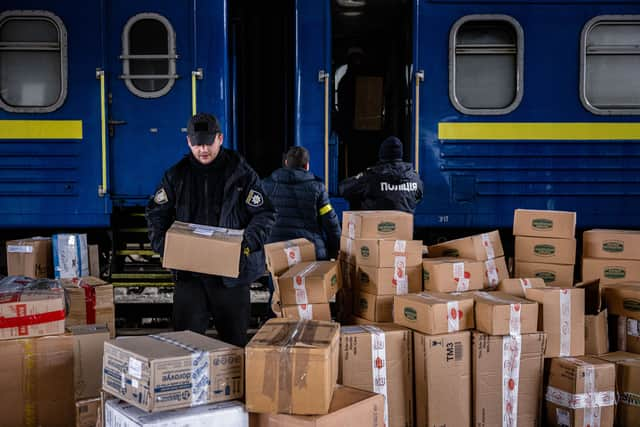How are charities helping people in Ukraine? Christian Aid’s Patrick Watt on the scale of the challenge
and live on Freeview channel 276
More than 100 days since it began, the war in Ukraine shows no signs of coming to any conclusion.
According to the United Nations, around 13 million people in the country have been displaced as a result of the crisis, with around five million seeking refuge in neighbouring countries.
Advertisement
Hide AdAdvertisement
Hide AdThere was a huge outpouring of support from the British public in the immediate aftermath of the crisis - but how is the aid money being spent now, and what issues are facing Ukrainian refugees?
NationalWorld spoke to Christian Aid chief executive Patrick Watt about the organisation’s work in the country.


How is aid being used?
Patrick, who was in Lviv in the west of Ukraine as we spoke, explains just how the £350 million raised so far in the DEC Appeal is being spent in part by Christian Aid.
“We are working in Romania, and in Hungary, supporting refugees there. But the bulk of our work, about three quarters of our work, is inside Ukraine. We felt it was important that we prioritise the situation inside Ukraine because that’s where the need is greatest.”
Advertisement
Hide AdAdvertisement
Hide AdHe adds: “Christian Aid tends to work through partners, we try not to employ lots of Christian Aid staff to do the work directly ourselves. We think it’s more sustainable if we’re supporting organisations that are already in the country.”
Will the same level of support continue?
However, as with any ongoing crisis, the level of public and financial support can begin to tail off the longer the conflict goes on. So what does this mean for aid being distributed in Ukraine?
“We’re responding in the aftermath, we’re responding here to a situation that’s ongoing, and we don’t know how long it will last,” Patrick says.


“The British public has been incredibly generous, but we don’t know that the same level of public attention and generosity can be assumed in the future. So that there’s a difficult judgement about the pace at which we spend, and how to make sure that what we’re doing is complementing what other organisations are doing.”
What issues are facing people in Ukraine as they attempt to flee the fighting?
Advertisement
Hide AdAdvertisement
Hide AdIt was reported that African students, as well as migrants, were facing racism while trying to flee Ukraine into neighbouring countries.
Patrick explains: “There was a situation of people being mistreated or treated differently at the borders, finding it harder to leave, in some cases being kind of actively abused by border authorities, on both sides of the borders.”
Most African nationals have now left Ukraine, but prejudice is still an issue as people continue to flee.
“What is definitely still an issue is the situation of the Roma people in Ukraine,” Patrick says. “There’s a long history of discrimination against the Roma community, particularly in Eastern Europe where there are bigger populations. So that is certainly something that we want to look at.”
Advertisement
Hide AdAdvertisement
Hide AdOften a forgotten demographic in war-torn countries is the elderly population. Christian Aid has been made aware of situations in which they have been left behind in under-fire locations due to their inability to move.


“In some cases, those elderly people are too frail or fragile to move. And so they’re being left behind,” Patrick says. “For older people who have lived through huge amounts of political turmoil and conflict, in some ways it must be re-traumatising.
“I was talking to a woman yesterday who had fled from a city in the east, and had come over to the west. She’d left her elderly father in a comatose state. It’s not at all a safe place for him to be left, but he just didn’t feel able to move at his age. She speaks to him daily but the question is what will happen to him long term and who is caring for him?”
Support people fleeing the devastating conflict in Ukraine: donate to the DEC appeal
Disasters Emergency Committee (DEC) charities and their local partners are in Ukraine and in neighbouring countries providing food, water, shelter and medical assistance. Learn more and donate what you can today
You can also donate to the DEC Appeals for Afghanistan and other crises at www.dec.org.uk
Comment Guidelines
National World encourages reader discussion on our stories. User feedback, insights and back-and-forth exchanges add a rich layer of context to reporting. Please review our Community Guidelines before commenting.
